MXA’S USED MOTOCROSS BIKE GUIDE: HOW TO SETUP YOUR 2010 HONDA CRF250
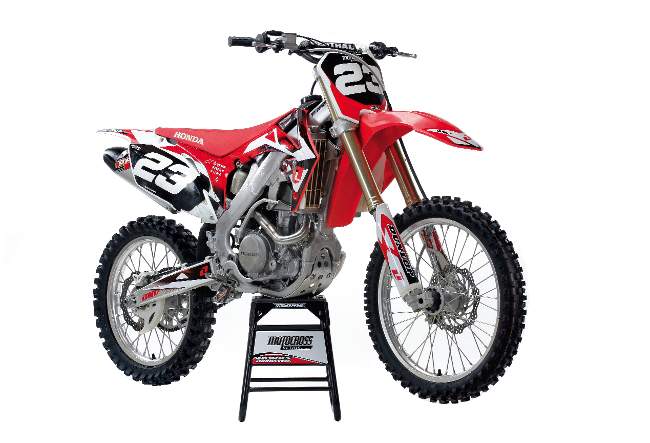
This is the 2010 Honda CRF250 the way the MXA test crew raced it. As a rule, we don’t go for exotic or expensive mods, but if push comes to shove, we will seek competent help (no matter how much it costs). Use MXA‘s mods as a guide.
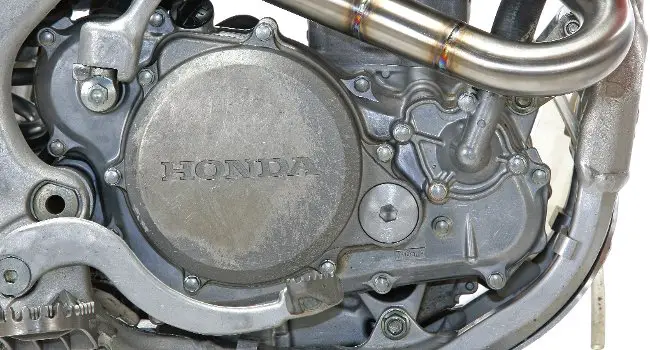
Clutch: We burned through the CRF250 clutch in six hours. Honda lengthened the 2010 clutch springs and added more coils. These changes provide a better clutch feel but don’t create enough grip. We ran $59.95 Hinson Hi-Temp clutch springs. For more information, call (909) 946-2942 or go to www.hinsonracing.com.

Exhaust pipe: The 2010 CRF250 needs an aftermarket exhaust system because the off-the-showroom-floor powerband is midrange-only. It lacks both bottom and top. We chose a $619.99 DR.D stainless steel/aluminum system (largely because DR.D always held the line on single-sided CRF250 exhausts). Call DR.D toll-free at (877) 382-2241 or visit www.dubachracing.com.

Front tire: The MXA test crew is always amazed when a bike comes out of the factory with a Dunlop D742FA mounted on it. Don’t the engineers care about all the hard work they put into designing the geometry? They must not, because this tire ruins handling. We changed front tires immediately to improve the turning characteristics of the CRF250. We prefer the Bridgestone 403/404 combo.
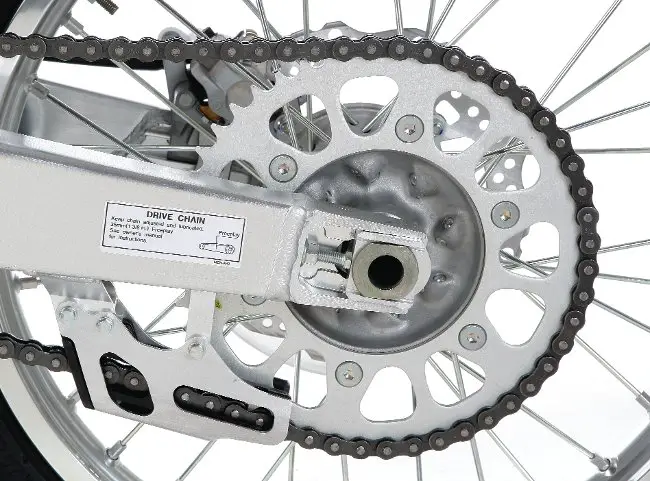
Gearing: We were pleased with the stock gearing and only bought a new sprocket (of the same size) when the stocker wore out. We also added a new Renthal R1 Works chain (www.renthal.com) at this time because the stocker has a very short life span.

Footpegs: For such a forward-thinking company, it’s shocking that Honda runs footpegs that Gottlieb Daimler would have used on the motorcycle he invented in 1885. The pegs are very narrow and quickly pack up with dirt. We switched to aftermarket pegs (and Honda updated their pegs in 2012).
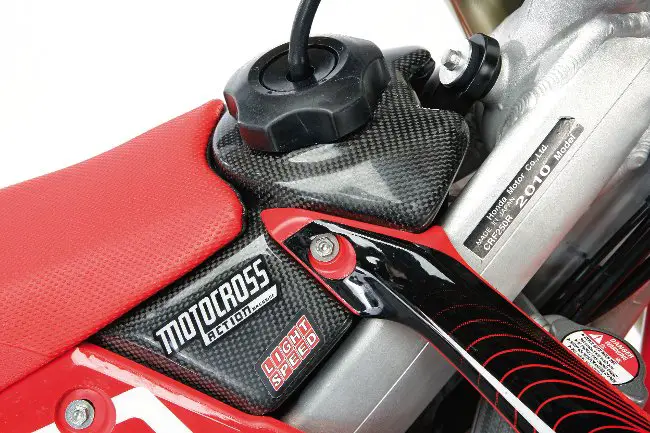
Miscellaneous: We added several cosmetic touches to our 2010 CRF250, including a $49.95 LightSpeed carbon fiber fuel tank cover (www.lightspeedperf.com). It didn’t do anything, but it looked cool. We also added a $59.95 a One Industries Delta graphics kit (www.oneindustries.com).

Forks: We made several major changes to help remedy the excessive headshake and improve handling. (1) We added stiffer fork springs to help the forks stay up in their stroke. (2) We dropped the fork legs down until they were flush with the top triple clamp to slow the oversteer down. (3) We ran the shock’s race sag at 105mm. (4) We tighten the steering stem nut underneath the top triple clamp. (5) We adjusted the steering damper to a more aggressive setting.
For hardcore racing, these are MXA’s recommended 2010 Honda CRF250 fork settings (stock settings are in parentheses):
Spring rate: 0.46 kg/mm (0.45 kg/mm)
Oil quantity: 342cc
Compression: 8 clicks out (13 clicks out)
Rebound: 8 clicks out (8 clicks out)
HPSD: 4 clicks out (8 clicks out)
Fork leg height: Flush with top clamp
Notes: The 48mm Showa forks come with a separate brass screw on top of the fork legs. Don’t use it to bleed air out of the forks! It is only to be unscrewed when the forks are being serviced. Use the aluminum screw to bleed air out of the fork legs. We believe that any rider over 150 pounds would benefit from stiffer fork springs.
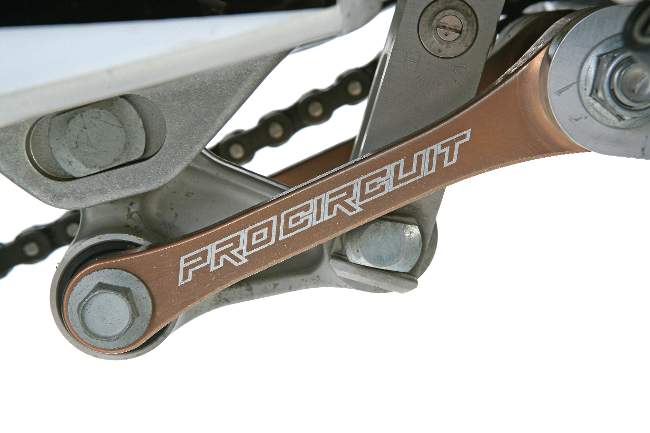
Shock: Since the 2010 CRF250 has the same basic chassis setup as the 2009-10 CRF450, we resorted to the same shock linkage trick that worked on the big bike. We ran a Pro Circuit CRF250 shock linkage that lowered the rear of the CRF250. This allowed us to manipulate the fork height and race sag across a wide enough range to control the CRF250’s tendency to oversteer and head shake. Go to www.procircuit.com for more info.
Here is what the MXA wrecking crew ran in its 2010 CRF250 (stock settings are in parentheses):
Spring rate: 5.3 kg/mm
Race sag: 105mm
Hi-compression: 1-1/16 turns out
Lo-compression: 7 clicks out
Rebound: 10 clicks out (11 clicks out)
Notes: The shock is very sensitive to high-speed compression. Heavier riders should go in 1/4 turn on high-speed compression and set the sag at 100mm.
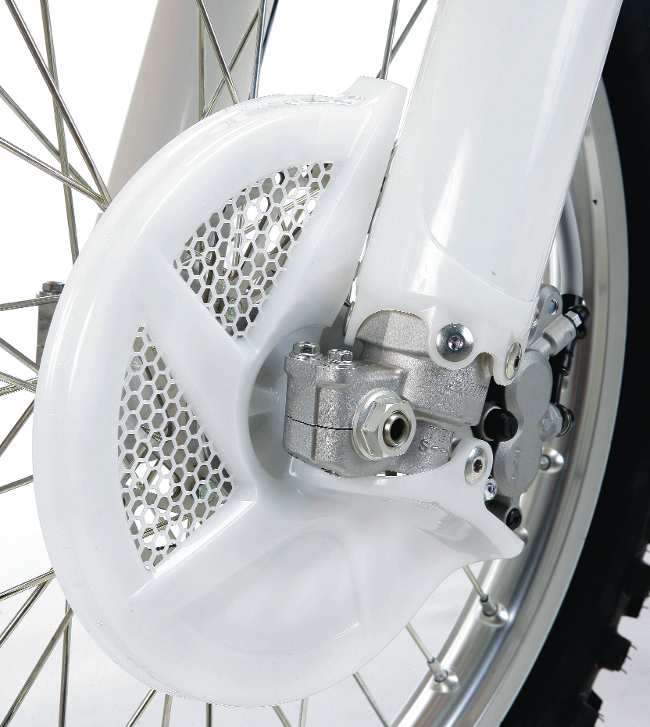
Brake guards: We removed the plastic disc guards (front and rear). The plastic guards reduce airflow to the brake rotors and cause heat fading. Ride Engineering (www.ride-engineering.com) makes a spacer to replace the one molded into the stock Honda front disc guard (or you can press the stocker out of the plastic).
Stuff we didn’t like on the 2010 CRF250: Nobody likes everything about a bike?here are the things that bothered us.
(1) Frame. This was a busy bike. It shook like a third-grader on a Butterfinger binge.
(2) Forks. In 2009 the CRF250 forks suffered from mid-stroke harshness. For 2010 the harshness is gone and has been replaced by soft fork springs.
(3) Clutch. We burned through the CRF250 clutch in short order. Honda lengthened and added more coils to the clutch springs. These changes provide a better clutch feel, but don’t create enough grip. Stiffer clutch springs are in order (last year’s clutch springs will not work as a replacement, as they are too short).
(4) Front tire. The day we no longer see a Dunlop D742FA on a production bike will be a great day.
(5) Footpegs. Good on a Hodaka, but the 201o CRF250 footpegs were worst in a class.
(6) Front brake guard. In 2009 Honda began using a front brake guard with the axle spacer molded into the plastic. We believe that the huge plastic brake guard hinders air flow to the rotor, causing the front brake to overheat. We remove the brake guard by pressing the spacer out on a press.
(7) Mud guard. The rear mud guard does its job of protecting the shock from harmful roost, but the chain gnaws it away in the process.




Comments are closed.